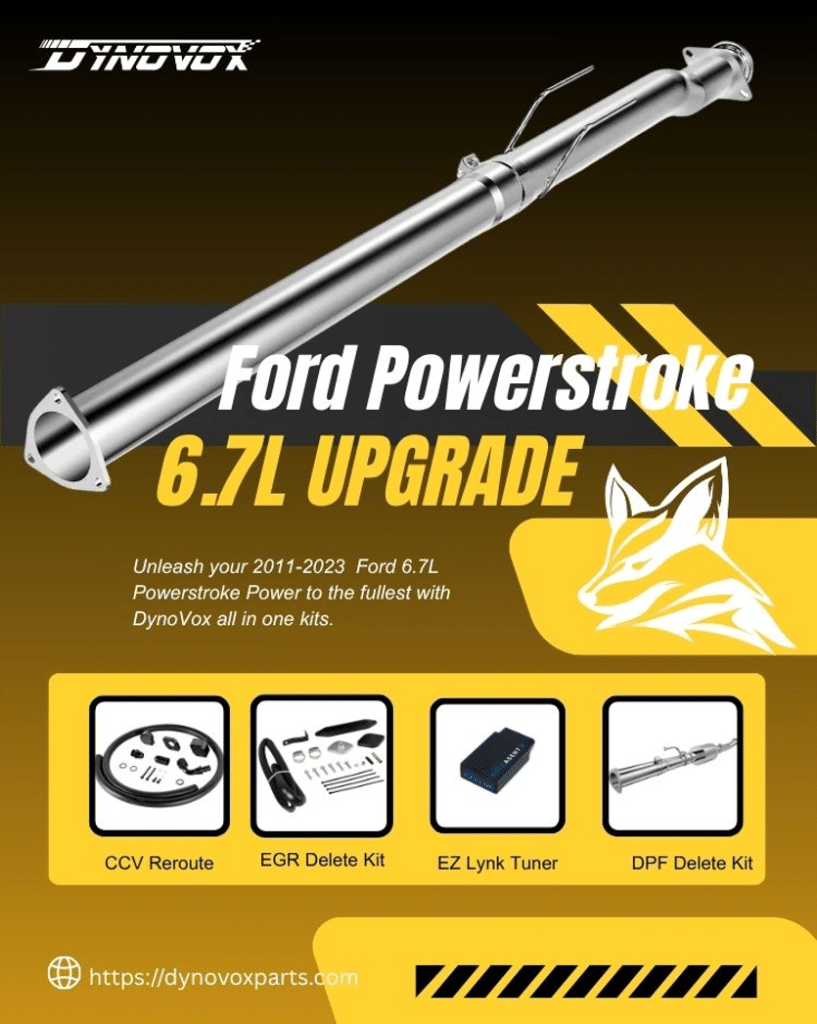The Ford 6.7L Powerstroke diesel engine is a powerhouse recognized for its torque, durability, and towing capacity. Found in Ford Super Duty trucks since 2011, it has earned its reputation as a workhorse for heavy-duty applications. However, many truck owners face limitations imposed by emissions components such as the Diesel Particulate Filter (DPF), Exhaust Gas Recirculation (EGR), and the Selective Catalytic Reduction (SCR) system. These systems, while designed to reduce emissions, can restrict engine performance, reduce fuel economy, and increase long-term maintenance costs.
For off-road and competition truck owners, deleting the emissions system offers a pathway to unlocking the engine’s full potential. In this in-depth guide, we explore everything you need to delete your 6.7L Powerstroke, from hardware to tuning considerations, with a special focus on ensuring long-term reliability and responsible performance gains.
The Performance Limitations of Factory Emissions Systems
The DPF and EGR systems are mandated to reduce pollutants such as particulate matter and nitrogen oxides (NOx). Although these technologies serve environmental purposes, they also bring significant mechanical compromises:
DPF-Induced Backpressure and Fuel WasteThe DPF captures soot within a ceramic filter structure. To maintain function, it periodically initiates a regeneration process that burns off accumulated soot by injecting additional fuel into the exhaust system. This process leads to a measurable increase in fuel consumption, even though it contributes nothing to actual propulsion. Furthermore, the backpressure created by the DPF reduces turbocharger efficiency and overall engine breathing.
EGR-Related Contamination and Thermal LoadThe EGR system diverts a portion of exhaust gases back into the intake manifold to reduce combustion temperatures and lower NOx emissions. Unfortunately, this reintroduces soot and acidic gases into the engine’s intake path, accelerating carbon buildup and increasing wear on components such as valves, intake ports, and turbo vanes. Prolonged exposure to recirculated exhaust can also cause premature EGR cooler failure.
In combination, these systems reduce engine efficiency, increase fuel consumption, and accelerate wear on critical components.
Quantifiable Benefits of a Full Delete
Removing the DPF and EGR systems and pairing them with custom tuning can achieve measurable gains in performance, efficiency, and reliability.
1. Horsepower and Torque:
Eliminating restrictive factory emissions components allows for improved exhaust flow and engine breathing. When combined with a professional tune that adjusts fuel delivery, timing, and turbo control, 6.7L Powerstroke owners can expect horsepower gains of 30 to 100 HP. Torque typically increases by 60 to 200 lb-ft, resulting in better throttle response, stronger acceleration, and enhanced pulling power—particularly useful for towing or off-road applications.
2. Fuel Economy:
A significant benefit of a delete is improved fuel efficiency. Removing the DPF eliminates regeneration cycles that waste fuel without propelling the vehicle. Additionally, eliminating EGR-related inefficiencies helps the engine operate optimally. Many users report highway fuel economy gains of 2 to 5 MPG, with heavy-duty applications noting even larger improvements. Trucks operating under load can experience fuel savings of 15% or more.
3. Engine Longevity:
EGR systems contribute to soot and carbon buildup, leading to premature wear on engine components. By removing the EGR circuit, the recirculation of exhaust gases stops, significantly reducing internal contamination. This cleaner environment means less frequent maintenance, fewer failures, and a reduced risk of clogging-related damage, ultimately preserving engine performance and extending service life—especially for commercial operators.
4. Operating Costs:
The financial benefits of a delete include avoiding costly DPF replacements and EGR cooler repairs. Removing these components minimizes maintenance needs and simplifies the exhaust architecture, leading to fewer failure points. This reduction in overhead makes a compelling case for users focused on performance in off-road or non-regulated environments.
Overall, a full delete not only restores the engine’s potential but also ensures maximum efficiency, lower stress, and reduced long-term costs.
What You Need for a Full Delete
To successfully perform a complete delete on your 6.7L Powerstroke, it is essential to combine both hardware and software components in a well-integrated system. A coordinated approach ensures that the engine continues to operate efficiently while preventing diagnostic errors, limp mode activation, or mechanical instability. Each component plays a specific role in restoring performance and eliminating emissions-related restrictions.
1. DPF/Catalytic Converter Delete Pipe
The first requirement is a replacement for the factory-installed Diesel Particulate Filter (DPF) and catalytic converter assembly. This is typically achieved using a straight or muffled delete pipe. For best results, the pipe should be constructed from high-quality stainless steel, such as SUS409 or T304, to provide resistance to corrosion and heat fatigue. Mandrel-bent tubing is also preferred, as it maintains consistent diameter throughout bends, which ensures maximum exhaust flow. A properly engineered delete pipe reduces backpressure and significantly improves turbocharger efficiency.
2. EGR Delete Kit
The next essential component is a complete EGR delete kit. This kit is responsible for removing the Exhaust Gas Recirculation system, which is a major contributor to internal carbon buildup. A comprehensive kit should include block-off plates to seal intake and exhaust ports, high-temperature gaskets to prevent leaks, and all necessary coolant rerouting hardware and hoses. The coolant system must be properly modified to ensure continued thermal stability after the EGR cooler is removed. It is also crucial to select a kit that is specifically engineered for your model year of the 6.7L Powerstroke, as Ford has made several design changes across different production cycles. Compatibility ensures proper fitment and avoids installation complications.
3. Tuning Device and Custom Calibration Software
Perhaps the most critical component of the entire delete process is the tuning solution. Without proper ECU recalibration, removing emissions systems will cause the truck to register diagnostic trouble codes (DTCs) and potentially enter limp mode. A professional tuning device allows for the modification of engine control parameters to reflect the absence of DPF and EGR systems. These changes typically include disabling sensors linked to the removed components, recalibrating air-to-fuel ratios for improved combustion efficiency, adjusting turbo timing and vane control logic, and suppressing DTCs associated with emissions-related hardware.
DynoVox offers tuning devices and custom calibrations that are purpose-built for deleted 6.7L Powerstroke engines. These solutions are carefully tested to ensure optimal safety, drivability, and power delivery. By using DynoVox’s dedicated software, users can expect a seamless transition from emissions compliance to performance-focused operation—ideal for off-road, racing, and non-public-road applications.
Legal Disclaimer and Off-Road Use Only
It is important to note that deleting emissions components from a vehicle that is operated on public roads is a violation of the Clean Air Act in the United States. Fines and legal consequences may apply. These modifications are marketed for off-road and competition use only. Make sure your vehicle complies with local, state, and federal laws before proceeding with a delete.
Long-Term Maintenance Tips After Deletion
Even after performing a full delete on the 6.7L Powerstroke, consistent maintenance is essential to ensure long-term engine reliability and performance. Monitoring exhaust gas temperatures (EGTs) becomes especially important, as reduced backpressure can lead to higher turbocharger speeds and elevated combustion temperatures under heavy load; installing an EGT gauge provides real-time data to help prevent thermal damage. Routine oil changes using high-quality synthetic diesel oil are also critical, as deleted engines often operate under increased stress and higher operating temperatures. Maintaining a clean and efficient air filtration system is equally important to protect both the turbocharger and intake tract from contaminants. Diesel fuel injectors should be cleaned or inspected at regular intervals to ensure precise fuel atomization, which supports combustion efficiency and power output. Additionally, the turbocharger itself should be periodically monitored for signs of excessive shaft play or declining boost pressure, as the increased flow potential introduced by the deletion may lead to higher RPMs and increased wear over time. By incorporating these maintenance practices, owners can preserve the benefits of their delete modifications while safeguarding engine health well into the future.
Why Choose DynoVox for Your Delete Kit?
DynoVox offers precision-engineered delete kits specifically tailored for the 6.7L Powerstroke platform. Each component is designed for long-term durability, easy installation, and optimal flow dynamics. In addition to hardware, DynoVox provides ECU tunes developed by professionals with deep knowledge of Ford diesel engine logic, calibrated for reliability and peak performance under all conditions. For a limited time, optimize your investment with code DYBL10 at checkout to secure 10% off your entire DynoVox delete system and tuning package.

Final Thoughts
Deleting the 6.7L Powerstroke’s emissions systems offers substantial benefits in power, fuel efficiency, and reliability—particularly for off-road use. However, such modifications demand a commitment to responsible ownership. Ensuring proper installation, ongoing maintenance, and legal compliance is critical.
For those ready to unlock the true performance of their Powerstroke engine, DynoVox provides the trusted solutions you need to upgrade with confidence. By combining quality components, expert tuning, and careful installation, truck owners can transform their driving experience while extending the engine’s lifespan.
Whether you haul, race, or explore remote terrain, a well-executed delete is your gateway to diesel excellence.
